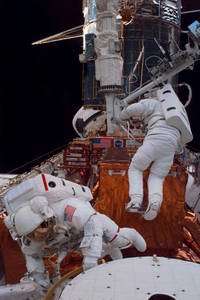Report: Astronauts, Not Robot, Should Fix Hubble Space Telescope

To ensure continuation of the extraordinary scientific output of the Hubble Space Telescope and to prepare for its eventual de-orbiting, NASA should send a space shuttle mission, not a robotic one, says a new congressionally requested report from the National Academies' National Research Council. The agency should consider launching the manned mission as early as possible after the space shuttle is deemed safe to fly again, because some of the telescope's components could degrade to the point where it would no longer be usable or could not be safely de-orbited, said the committee that wrote the report.
Hubble Space Telescope:
Hubble was originally designed in the 1970s and launched in 1990. Thanks to on-orbit service calls by the Space Shuttle astronauts, Hubble continues to be a state-of-the-art space telescope. Hubble orbits 600 kilometers (375 miles) above Earth, working around the clock to unlock the secrets of the Universe. It uses excellent pointing precision, powerful optics, and state-of-the-art instruments to provide stunning views of the Universe that cannot be made using ground-based telescopes or other satellites.
Hubble is the first scientific mission of any kind that is specifically designed for routine servicing by spacewalking astronauts. It has a visionary, modular design which allows the astronauts to take it apart, replace worn out equipment and upgrade instruments. These periodic service calls make sure that Hubble produces first-class science using cutting-edge technology. Each time a science instrument in Hubble is replaced, it increases Hubble scientific power by a factor of 10 or greater!
"A shuttle servicing mission is the best option for extending the life of the Hubble telescope and ultimately de-orbiting it safely," said committee chair Louis J. Lanzerotti, distinguished research professor at the New Jersey Institute of Technology, Newark, and consultant, Bell Laboratories, Lucent Technologies, Murray Hill, N.J. "NASA's current planned robotic mission is significantly more technologically risky, so a robotic mission should be pursued only for the eventual removal of the Hubble telescope from orbit, not for an attempt to upgrade it. Also, a shuttle mission could be used to place equipment on the telescope to make a robotic de-orbiting mission more feasible."
The Hubble telescope, which has operated continuously in orbit for the past 14 years, was designed to be serviced regularly by astronauts. Four servicing missions replaced nearly all the key components while increasing the telescope's capabilities. The fifth and final mission -- to replace aging batteries, fine-guidance sensors, gyroscopes, and two scientific instruments -- was originally intended to be completed by a shuttle crew as well, but NASA is currently planning an unmanned mission to service the telescope robotically.
The committee's principal concerns about a robotic mission are the risk of failing to develop it in time and the risk of a mission failure, as well as the possibility that the robot could critically damage the telescope. A robotic mission would face significant challenges in using its grapple system to perform autonomous close-proximity maneuvers and the final capture of the space telescope -- activities that have no precedent in the history of the space program and whose chances of success are low, according to the committee.
"Our detailed analyses showed that the proposed robotic mission involves a level of complexity that is inconsistent with the current 39-month development schedule," said Lanzerotti. "The design of such a mission, as well as the immaturity of the technology involved and the inability to respond to unforeseen failures, make it highly unlikely that NASA will be able to extend the scientific lifetime of the telescope through robotic servicing."
The committee assessed the safety risks of a shuttle servicing mission by comparing shuttle missions to the International Space Station -- to which NASA plans to send 25 to 30 more shuttle flights -- and shuttle missions to the Hubble telescope. The differences between the risks faced by the crew of a single shuttle mission to the space station and the risks faced by the crew of a mission to the Hubble telescope are very small, the committee concluded.
Also, a shuttle crew would be able to successfully carry out unforeseen repairs to the Hubble telescope and develop innovative procedures for unexpected challenges in orbit, the report notes. Such contingencies have been successfully addressed on three of the four prior missions to the telescope. A robotic mission, on the other hand, might not be able to repair failures that it is not designed to address, possibly stalling the mission in its early stages.
"With the replacement of aging components and the installation of new science instruments, Hubble is expected to generate as many new discoveries about stars, extra-solar planets, and the far reaches of the universe as it has already produced so far, with images 10 times more sensitive than ever before," Lanzerotti said.
















